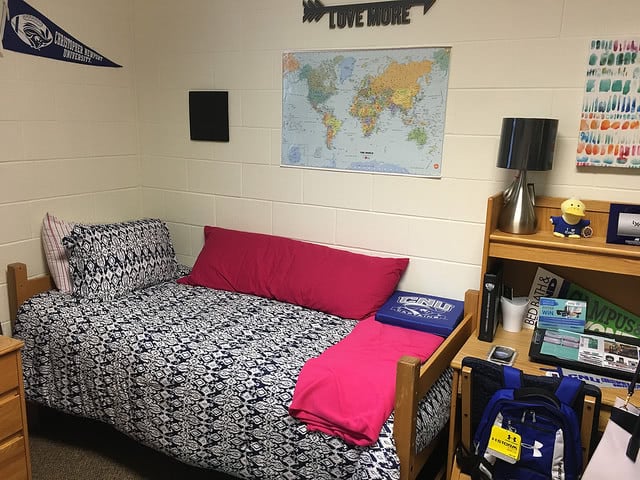Tuition, room, and board are not the only college expenses to consider when you start your education. There are also hidden college costs to account for as well. While tuition is often the biggest expense, smaller, hidden costs can add up and be almost just as much. It’s important to budget for these invisible college costs so you’re not surprised if you end up spending way more than you expected. Budgeting for these ten expenses will ensure you’re taking the right amount of loans out and will prevent you from pinching pennies at the end of the semester.
1. Textbooks, Access Codes, and School Supplies
Full-time undergraduate students at four-year institutions spent an average of $1240 on books and supplies during the academic year 2021-22. This is from a report published by The College Board. During that same academic year, undergrad students at two-year public institutions spent an average of $1460 on books and supplies.
We all know that textbooks are a huge cost to budget for when attending school. You may need to purchase scantrons, iClickers, lab gear, and other supplies for certain classes. Did you know that some classes require an additional online access code for compatible course content? These access codes can range from $50 to $200 depending on the class. If you are taking 4 classes per semester and each one requires a code, you could be spending an extra $200 to $800 just for mandatory course content.
School supplies also often go under the radar for college expenses because we usually think that a few notebooks and pencils can hold us over. Some students like to have their own personal laptops, tablets, and compatible accessories to make studying easier. If you don’t own your own laptop, you’ll have to constantly use your school’s available computers in hopes of finding an open one. You’ll also have to schedule a time to come to campus and work on your schoolwork instead of being able to conveniently do it wherever you can find wifi like you would with a personal computer.
2. Transportation and Parking Fees
Transportation costs will vary widely depending on the campus location and layout. Where you live and the type of transportation available will also impact the total cost of transportation.
If you drive your own vehicle, you’ll need to add the cost of a parking garage at your residence, gas to drive around, and a campus parking pass.
Having a car in college is super convenient because you won’t have to worry about the school shuttle schedules interfering with your class times. Bringing your car to college does cost money though. To park at your campus, you have to pay a semester parking fee which can cost upwards of $100 depending on your school. You’ll also have to pay for gas and maintenance that your car needs while you’re away at college. This hidden cost could be costing you almost $500 a semester depending on how often you drive your car.

3. Clubs and Organizations
Being a part of clubs and organizations in college is a great way to strengthen your resume and make friends. They are a lot of fun and a great way to interact with your peers outside of the classroom. Though there are some free clubs to join, some may cost you. You have to pay to become a member of any college club or to attend any sporting event on campus. If you’re a very social person who loves being everywhere, you’ll need to set aside a generous budget for these activities every year.
4. Greek Life
There’s so much mysticism and fanfare associated with Greek life. It’s something almost every freshman student looks forward to being a part of until they get to know how much it costs to join. The cost of Greek life can range anywhere from $600 to $4000 or even more. That’s per semester and it’s only the cost to sign up. Once you’re in, there are several other ongoing expenses, from service projects to charitable contributions and rush events.
Yes, Greek life is one of the bigger hidden college costs. Fortunately, it’s optional, so you don’t have to stress over it if it’s out of your budget.
5. Groceries and Food
If you have a meal plan included in your tuition, groceries, and food expenses may not be a cost to consider when budgeting for college. Students who live off-campus or opt out of a dining plan will have to think about their monthly grocery bills. Putting aside at least $100 a month for groceries, which is on the lower end of costs, will set you back a few hundred dollars a semester. You can shop the grocery store sales and use your school’s food pantry if they have one available for students.
6. Dorm or Apartment Necessities
Though dorm rooms and most off-campus housing apartments come furnished, they do not come decorated. If this is to be your home for the next few years, making it feel like yours is super important. The right bed linens, towels, pillows, mattress toppers, and storage containers are just the tip of the iceberg for dorm and apartment supplies.
If you’re living in an apartment, you may also need to buy kitchenware and other household items to make your living space more functional. The costs of furnishing and decorating are definitely hidden college costs that you need to take into consideration.
The great thing about this hidden cost is that you usually only have to do it once or twice during your entire college career. You can keep most of the stuff you bought your freshman year if you buy durable products.
7. Social Outings
College is a great place to go out and meet new people. Unfortunately, going out is not always cheap. Budget some of your money to be able to still attend social events and outings with friends without overspending. We suggest saving it for the days of the week that seem to be the most fun for your college town or going during the hours of discounted fun.
8. Internships
Internships don’t cost money to apply to or have, but some of them are unpaid so you could be losing money. If you give up your part-time job for an internship to get a better experience, you won’t have any income during that time. You also may need to buy the proper attire if you don’t already have it. Many internships require you to dress professionally, so clothing costs may add up.
9. College Games (Sporting Events)
If you attend a super big college, you may have to pay to get into the college games. Sports are a huge culture for some colleges so being able to attend the games is important for a lot of students. See which college games are free to get into at your school and look up if there is a way to get discounted tickets. If tickets are too expensive, you can always attend the tailgates and watch it on the big screen.
10. Mandatory Fees
Along with your tuition, each school will add on extra fees that students often don’t even look at when they get their semester bills. These fees can include distance learning fees, lab fees, athletic fees, and more. Though they are usually not too expensive, they’re still something you need to budget for when paying your semester tuition at the beginning of each school year.
11. Emergencies
It’s no secret that emergency situations can cost you a pretty penny when they arise. Whether you need to buy a last-minute plane ticket home or need to replace your car tires, having an emergency fund is super important. We suggest putting aside $500 to $1,000 for emergency use only and if you don’t use it, you can always keep it for the next semester.
12. Tuition Creep
As far as hidden college costs go, tuition creep is pretty significant. And yet nobody talks about it when discussing the cost of college.
Almost all colleges raise their tuition by about 3-5% every year. This increase applies to new admissions as well as current students. Very few schools do not apply the annual increase in tuition fees to students already enrolled in four-year programs.
When comparing college costs before making your final decision, you must factor tuition creep into your calculation.
When it’s time to create a budget and do a breakdown of costs for everything college-related, make sure you keep these hidden cost of college expenses in mind. Not only will you save yourself a headache when you find out there was more to pay for than you thought, but you’ll allow yourself to save money in the long run. When you know how much money you have, you can focus more on your schoolwork and less on your finances. Hidden college costs shouldn’t keep you from enjoying your semester, so we’re bringing them to light.
| Lender | Rates (APR) | Eligibility | |
|---|---|---|---|
 |
5.50%-16.12%* Variable
3.99%-15.61%* Fixed
|
Undergraduate and Graduate
|
VISIT CITIZENS |
 |
5.54% - 15.70% Variable
3.99% - 15.49% Fixed
|
Undergraduate and Graduate
|
VISIT SALLIE MAE |
 |
4.63% - 17.99% Variable
3.49% - 17.99% Fixed
|
Undergraduate and Graduate
|
VISIT CREDIBLE |
 |
6.00% - 13.75% Variable
3.99% - 13.75% Fixed
|
Undergraduate and Graduate
|
VISIT LENDKEY |
 |
5.66% - 14.72% Variable
3.69% - 14.56% Fixed
|
Undergraduate and Graduate
|
VISIT ASCENT |
 |
3.70% - 8.75% Fixed
|
Undergraduate and Graduate
|
VISIT ISL |
 |
5.62% - 16.85% Variable
3.69% - 16.49% Fixed
|
Undergraduate and Graduate
|
VISIT EARNEST |
 |
5.00% - 14.22% Variable
3.69% - 14.22% Fixed
|
Undergraduate and Graduate
|
VISIT ELFI |








